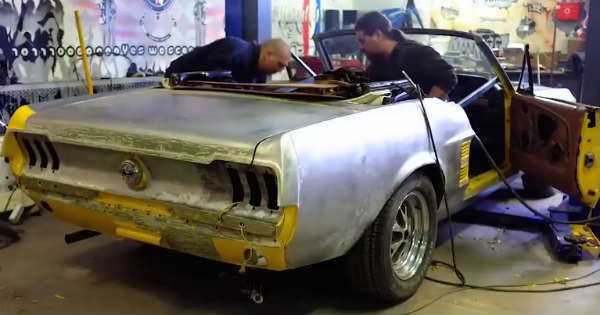There’s something undeniably captivating about classic cars, with their timeless designs, nostalgic charm, and the echoes of a bygone era. Many enthusiasts dream of owning, driving, and preserving these vintage treasures, and classic car restoration is the gateway to making that dream a reality. In this comprehensive guide, we’ll take you through the step-by-step process of getting started with classic car restoration, from finding the perfect project car to the exhilarating moment when you finally take it for a spin.

1. Define Your Vision and Goals
Before diving headfirst into the world of classic car restoration, it’s crucial to define your vision and goals. What type of classic car do you want to restore? Do you have a specific make, model, or era in mind? Knowing your preferences and objectives will help you stay focused throughout the restoration process and make informed decisions along the way.
2. Research and Education
Classic car restoration is a labor-intensive and detail-oriented undertaking. It’s essential to educate yourself about the specific car you’re interested in restoring, as well as the restoration techniques and processes involved. Utilize resources such as books, online forums, and experienced restorers’ advice to gain a deep understanding of your chosen project.
3. Set a Realistic Budget
Restoring a classic car can be expensive, and costs can quickly escalate if you’re not careful. Establish a realistic budget for your project, accounting for the purchase price of the car, parts, tools, labor, and any unexpected expenses that may arise. A well-defined budget will help you stay on track and avoid financial stress down the road.
4. Locate the Perfect Project Car
Finding the right project car is a critical step in your classic car restoration journey. Start by attending car shows, scouring online classifieds, and reaching out to fellow enthusiasts. Be patient, as it may take time to find a car that aligns with your vision and budget. When assessing potential project cars, pay close attention to the vehicle’s condition, structural integrity, and the availability of replacement parts.
5. Assemble the Necessary Tools and Equipment
To restore a classic car, you’ll need a set of specialized tools and equipment. This includes items like wrenches, socket sets, jack stands, sanders, paint sprayers, and more. Invest in quality tools that will stand the test of time and make the restoration process more efficient. If you’re unsure about what you’ll need, seek guidance from experienced restorers or auto shops specializing in classic car restoration.
6. Create a Restoration Plan
A well-thought-out restoration plan is a roadmap to success. Detail each step of the restoration process, from disassembly to reassembly, and establish a timeline for each task. This plan will serve as a reference point and help you stay organized throughout the project.
7. Disassembly and Assessment
With your project car in your garage and your plan in hand, it’s time to begin the disassembly process. Carefully remove all components, documenting and labeling each part to ensure proper reassembly. While disassembling, assess the condition of each component, noting what needs repair, replacement, or restoration.
8. Repair and Restoration
Now comes the heart of the restoration process. Depending on your car’s condition and your goals, this phase may involve tasks such as bodywork, welding, engine rebuilding, upholstery, and more. It’s essential to tackle one area at a time, prioritizing safety and quality craftsmanship. Seek professional assistance from custom shops such as Plum Crazy Restorations if you encounter challenges beyond your expertise.
9. Sourcing Replacement Parts
Finding authentic replacement parts for a classic car can be a treasure hunt in itself. Specialized suppliers, salvage yards, and online platforms offer a wide range of parts, from engine components to interior trim. When purchasing replacement parts, verify their compatibility and quality, and be prepared to refurbish or recondition some components to meet your restoration standards.
10. Paint and Finish
The paint and finish of a classic car are crucial aspects of its overall appearance. If you have the skills and equipment, you can undertake this step yourself. However, many restorers opt to entrust this stage to professionals to achieve a flawless finish that does justice to the car’s original aesthetics.
11. Reassembly and Finishing Touches
As the restoration nears completion, it’s time to reassemble the vehicle. Refer to your documentation and labels to ensure everything goes back together correctly. This is also the stage where you’ll add finishing touches like chrome trim, decals, and other distinctive features that make your classic car truly unique.
12. Testing and Quality Assurance
Before hitting the open road, it’s vital to test all systems thoroughly. Check the engine, transmission, brakes, and electrical systems to ensure they’re in proper working order. A professional inspection can provide peace of mind and help address any lingering issues.
13. Final Adjustments and Refinements
Classic car restoration is a meticulous process. Even after the initial testing, you may need to make final adjustments and refinements to achieve perfection. This stage is about fine-tuning every detail to ensure your restored classic car not only looks incredible but also performs admirably.
14. Enjoy Your Classic Car
Once you’ve completed the restoration and addressed all the details, the moment you’ve been waiting for arrives: it’s time to enjoy your classic car. Take it for a spin, showcase it at car shows, and bask in the satisfaction of having resurrected a piece of automotive history.
Classic car restoration is a labor of love that demands patience, dedication, and a passion for automotive heritage. With the right guidance, tools, and knowledge, anyone can embark on this rewarding journey and breathe new life into a vintage masterpiece. Whether it’s a ’67 Mustang, a ’57 Chevy, or a ’69 Camaro, the thrill of restoring a classic car is an adventure like no other. So, get started on your classic car restoration project and let your passion for vintage automobiles shine. Your dream of driving down memory lane in a meticulously restored classic car is well within reach.

